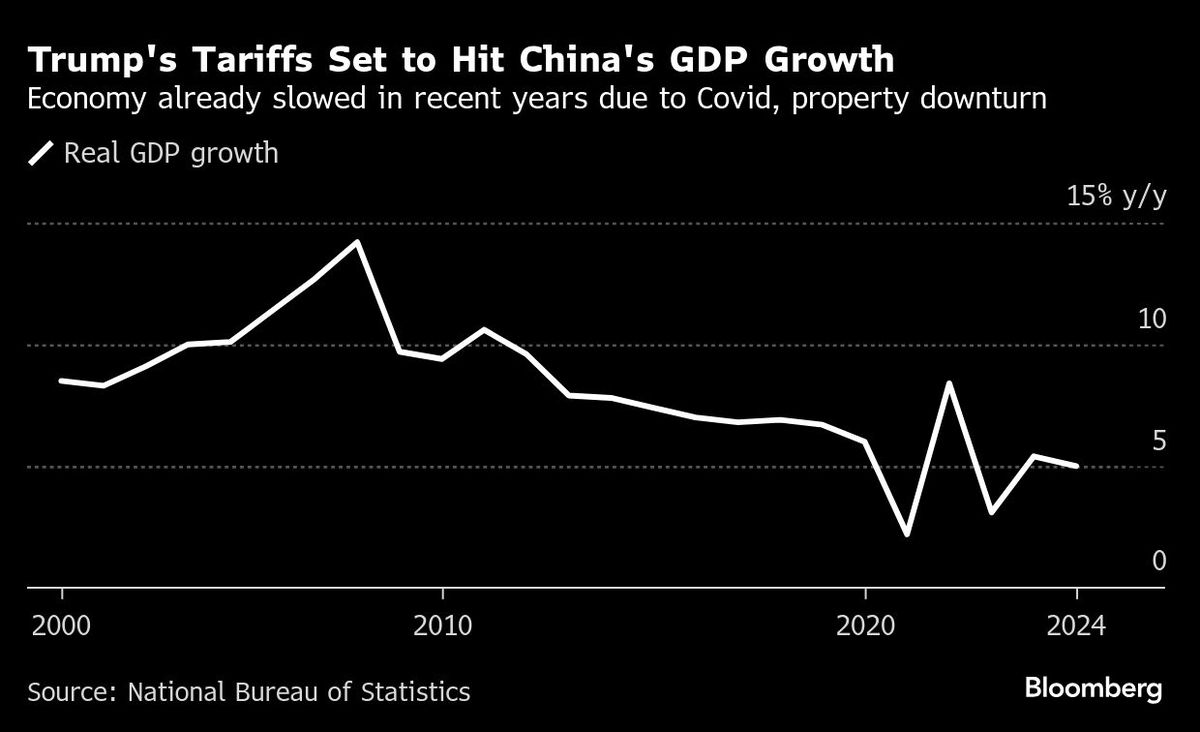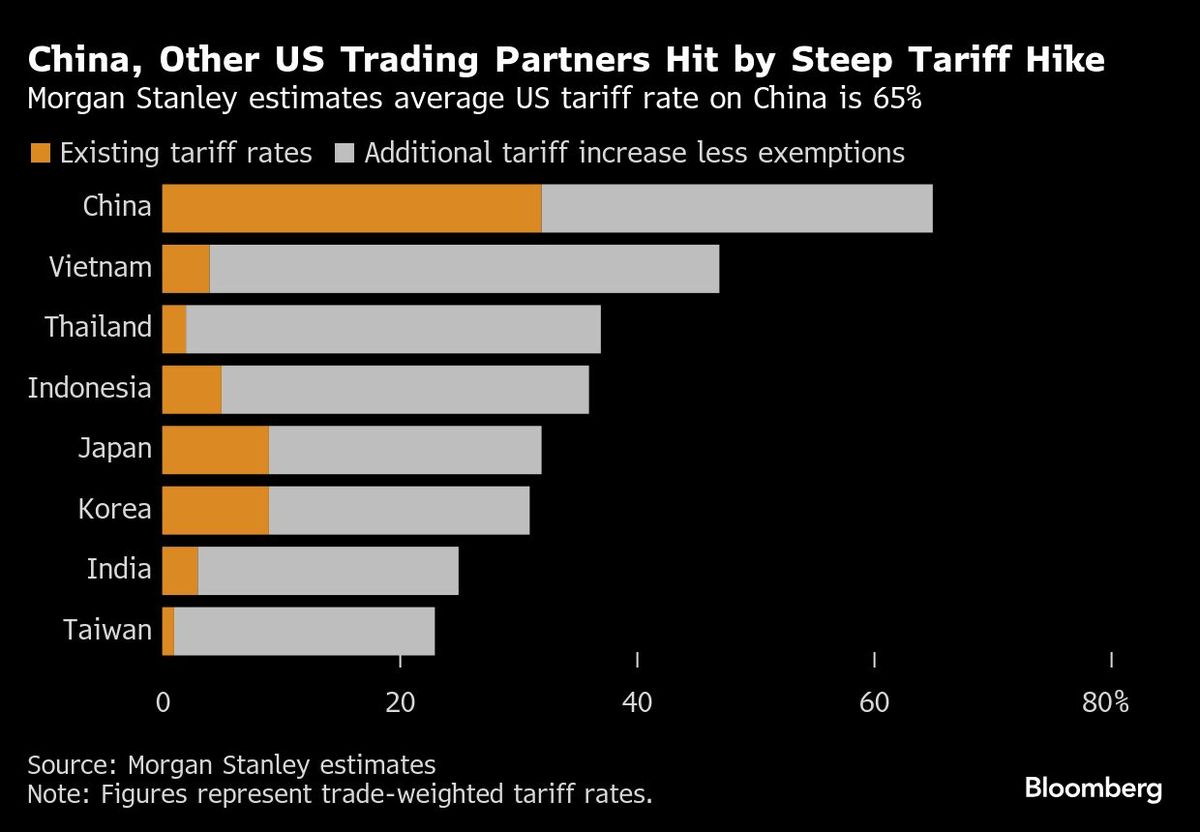
(April 3): Donald Trump’s latest tariff hikes threaten to inflict a bigger hit on China’s economy than it suffered during his first trade war.
The 54% US tariffs on China’s goods announced since the start of Trump’s second presidential term may drag the country’s gross domestic product growth down by 2.4 percentage points in 2025, according to Citigroup Inc, an assessment it says was made before considering any offsetting measures.
Economists at BNP Paribas, Societe Generale SA, Oversea-Chinese Banking Corp and ING Bank forecast a hit of one to two percentage points.
“The US tariff shock would be significantly higher and more pervasive than 2018-19,” Morgan Stanley economists led by Robin Xing said in a report. “Besides the direct tariff shock on China’s exports to the US, the indirect impact would also be notable, as the US’ pervasive tariff hikes on other trading partners would slow global trade.”
A severe slowdown will likely prompt Chinese policymakers to roll out more stimulus. That could come in the form of several trillion yuan in additional government spending or a liquidity boost to banks, some economists said.
Senior officials have repeatedly signaled they’re ready to act to offset external shocks. Beijing on Thursday also condemned the US levies and pledged to hit back with unspecified measures.
“It would be easy for China to roll out another one to two trillion yuan special sovereign bonds if necessary,” said Serena Zhou, senior China economist at Mizuho Securities Asia.
The government already planned to issue 1.3 trillion yuan (US$179 billion or RM802.1 billion) of ultra-long special sovereign bonds this year and use some of the proceeds to subsidise purchases of consumer goods.
The trade standoff may wallop the economy just as its performance was steading in the beginning of 2025, with little sign of damage from tariff increases so far.
The recovery momentum has led at least seven international banks including Morgan Stanley and Citigroup to upgrade their forecasts to China’s 2025 GDP growth over the past month.
The improved sentiment could falter now after the latest tariff announcements. It may also put this year’s ambitious growth target of around 5% out of reach in the absence of more policy stimulus.
“The tariffs, if implemented, will hurt China on multiple fronts, by weakening demand for China’s products in the US and hitting the world economy. What’s more, the US action risks stronger retaliation from other trading partners — further depressing global demand,” Bloomberg Economics said.
“The tariff impact could start to be seen from the second quarter of 2025,” Citigroup economists including Yu Xiangrong wrote in a note Thursday. “We now see a 50-100 basis points downside risk to our 4.7% GDP forecast, pending potential extra stimulus.”
The Communist Party’s decision-making body Politburo will convene in late April and July to discuss the economic outlook and policies — meetings it could view as potential windows for unveiling major policy adjustments.
Other channels for stimulus include a cut to the reserve requirement ratio for banks, which would unlock cash they can lend or invest. Analysts had flagged such a move as a likely response from the People’s Bank of China to massive tariff hikes.
“We think the probability of an RRR cut in April is rising, given the needs to inject liquidity as well as to support market sentiment,” said Zhi Xiaojia, chief China economist at Credit Agricole CIB in Hong Kong.
One silver lining for China is that many other US trading partners have also been targeted with steep increases in levies.
The result is likely a narrower gap in terms of US tariff rates between China and some of its trade competitors, such as Vietnam. As a consequence, this could potentially moderate the impact on China, as it may become costlier to substitute its products with imports from other countries.
What this means is that the eventual impact of the tariffs on China’s exports and economy remains difficult to quantify.
“The situation is more nuanced this time” compared with Trump’s first term, said Tommy Xie, head of Asia macro research at Oversea-Chinese Banking Corp. “Ultimately, the real economic cost may depend more on substitution limits than the nominal tariff rate itself.”
Read also:
Trump's tariffs stoke global trade war as China, EU vow response
Here are Trump’s reciprocal tariffs by country
Uploaded by Magessan Varatharaja
- Trump open to tariff cuts in return for ‘phenomenal’ offers
- China hits back at Trump with tariffs, limits on key exports
- Mr DIY founder Tan Yu Yeh relinquishes vice chairman post, to serve as adviser
- Karpal Singh Drive residents urge state government to halt land reclamation for Jelutong Landfill project
- 25 Putra Heights fire victims lent first batch of Chery Malaysia SUVs for a month on Friday
- Discover Global Career Opportunities at the GBA | Guangdong-Hong Kong-Macao Talent Development Showcase cum Career Fair
- Fed's Powell says larger-than-expected tariffs mean higher inflation, slower growth
- Zafrul to chair special Asean meet to discuss implications, coordinate response on US tariffs
- Putra Heights fire: 46 still being treated, one in ICU — MOH
- Chinese airline competition lowering Lufthansa's Asia profits, executive says


